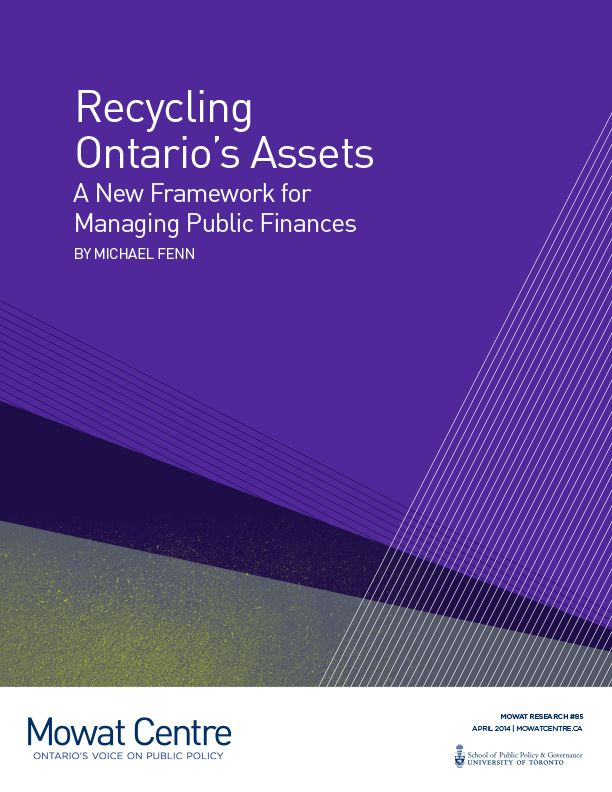April 11, 2014
A New Framework for Managing Public Finances
This report uses the concept of “asset recycling” to outline a new framework for public asset management and reinvestment that protects the public interest while maximizing revenue generation for public purposes.
Executive Summary
Canada’s infrastructure is aging and significant new investments are required. Raising new revenues through increased taxation is one option to respond to this urgent need. Yet governments and the public are resistant to this approach. But another option exists. It is called “asset recycling.”
Put simply, “asset recycling” requires governments to dispose of legacy assets to generate capital to invest in new assets or to refurbish existing infrastructure. Australia points the way. In the past six years, more than half of all infrastructure construction (valued at A$36B over the past six years) has been funded by the private sector, generally by recycling public assets. Many of these capital investments provide ‘public goods’ that would otherwise not be available to the public, as well as delivering significant, sustainable returns for pension funds.
Governments around the world are re-examining how they ensure maximum public value from their assets. But in Canada we often maintain public ownership when we shouldn’t—or dispose of our assets in haphazard ways. Globally, new approaches to asset management that protect the public interest while maximizing revenue generation have emerged and should be considered.
An informed public discussion about how Canadian governments should manage and monetize their public assets is overdue. That discussion must include the many successful approaches that are being used globally to monetize assets while protecting the public interest. Traditional 20th century debates between public ownership and privatization are increasingly irrelevant to the real choices facing governments.
Continue Reading
This paper is intended to help governments develop a framework for managing and monetizing public assets. Some of the key recommendations include:
» Federal and provincial governments should follow the lead of municipalities and clearly separate operating from capital revenues and expenditures. Debt financing to invest in long-life capital assets like infrastructure should be acceptable, while operating deficits should be avoided. This can only occur if budgets distinguish operating from capital more clearly.
» Governments should develop frameworks for managing their assets, beginning with understanding what they own, and why. Asset management frameworks should identify the policy purpose for owning an asset and determine whether the original purpose is still compelling. Policy makers should look objectively at the alternatives available to protect the public interest, while increasing revenues to be used for public purposes.
» Governments should improve their capacity to manage assets by hiring those with the expertise necessary to monetize assets. Asset planning should take place centrally, rather than be undertaken by individual ministries and other government entities. Decentralized, departmental asset management often diminishes the public value of our assets, and individual departments are not always well-placed to make integrated decisions regarding the disposition of assets.
» Many of the accounting, audit, and tax rules currently governing the disposition of public assets will need to be reformed. We have designed these rules with the public interest in mind, but some have come to undermine good public policy. Currently, it is often necessary to book the proceeds from an asset sale in the year in which the sale took place, rather than allowing the proceeds from an asset sale to be saved, invested or deployed in ways that re-invest in public assets over a longer time horizon.
» A formal policy of asset recycling should be adopted, with the proceeds from asset disposition put into an Infrastructure Trust. This Trust would ensure that revenues from asset disposition would be used to invest in new, priority infrastructure. Such a Trust could take on the characteristics of an Infrastructure Bank.
Canada’s current economic success and productivity stands on the infrastructure foundation built and financed by capital investment, including bonds and debentures issued in the low-interest decades following World War II. These post-war investments were then complemented by civic, hospital and educational infrastructure investment financed from development charges, philanthropy, debt-financed capital grants from the provinces, and periodic federal capital funding.
Our current prosperity and quality of life stand on the shoulders of these past investments. From transit facilities and water lines, to energy infrastructure and recreational facilities, the need for new investment by governments is abundantly clear to citizens. We must either raise taxes to fund new investments or find ways of monetizing our current assets. This paper recommends a new strategic framework for asset management, referred to as asset recycling, that would protect the public interest, increase revenues with reduced burden on taxpayers, and permit a new wave of infrastructure renewal.








